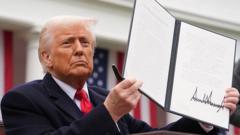The negotiations, fraught with tension, saw Japan asserting its leverage through its substantial holding of US Treasury bonds, creating a narrative where Japan exhibited a rare level of defiance. The outcome of this agreement may act as a catalyst for other nations, notably the EU, which has been hesitant to yield in its trade disputes with the US.
In the wake of this deal, where Japan managed to preserve its agricultural protections while agreeing to increase US rice imports, analysts are eagerly anticipating the implications for other global economic entities. Japan’s Prime Minister, facing domestic political pressures, opted to secure the deal now rather than risk a more punitive situation with Trump’s looming threats of even higher tariffs in the future.
As tariff revenues are enriching the US Treasury significantly, emerging data indicates that the revenue from tariffs is contributing a larger percentage of federal revenue than typically seen. However, the true cost may fall on US consumers, as these tariffs introduce higher prices for imported goods, compounded by the declining value of the dollar against other currencies.
Further complicating the scene, the central banking community is observing a “crowded trade” against the dollar, raising questions about its status as a stable reserve currency. Although the tariffs are intended to bolster US manufacturing, they may unintentionally enhance China's appeal as an international trade partner.
In this intricate web of global trade relations, the deal with Japan is being portrayed as a significant achievement for Trump, pushing back against claims of his administration yielding under pressure. However, with critical deadlines approaching and broader economic implications at play, the overall trade landscape remains complex and fraught with risks.
In the wake of this deal, where Japan managed to preserve its agricultural protections while agreeing to increase US rice imports, analysts are eagerly anticipating the implications for other global economic entities. Japan’s Prime Minister, facing domestic political pressures, opted to secure the deal now rather than risk a more punitive situation with Trump’s looming threats of even higher tariffs in the future.
As tariff revenues are enriching the US Treasury significantly, emerging data indicates that the revenue from tariffs is contributing a larger percentage of federal revenue than typically seen. However, the true cost may fall on US consumers, as these tariffs introduce higher prices for imported goods, compounded by the declining value of the dollar against other currencies.
Further complicating the scene, the central banking community is observing a “crowded trade” against the dollar, raising questions about its status as a stable reserve currency. Although the tariffs are intended to bolster US manufacturing, they may unintentionally enhance China's appeal as an international trade partner.
In this intricate web of global trade relations, the deal with Japan is being portrayed as a significant achievement for Trump, pushing back against claims of his administration yielding under pressure. However, with critical deadlines approaching and broader economic implications at play, the overall trade landscape remains complex and fraught with risks.






















